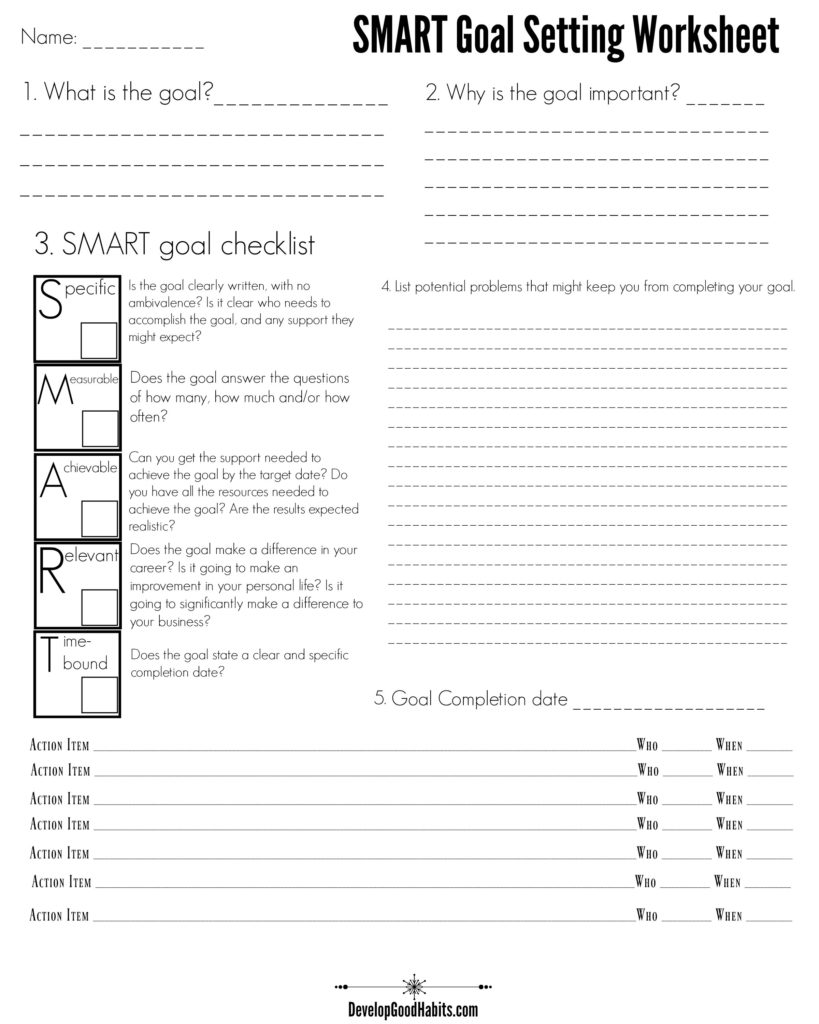
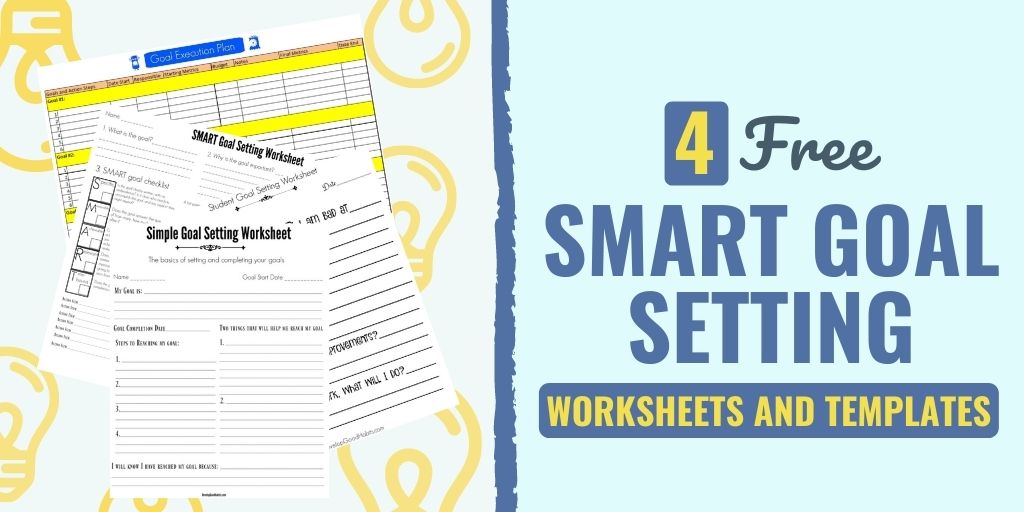
There might be affiliate links on this page, which means we get a small commission of anything you buy. As an Amazon Associate we earn from qualifying purchases. Please do your own research before making any online purchase.
Many people fail in their goals.
The big reason why is they fail to have a plan.
I am sure you've heard the quote:
There is a lot of wisdom in that quote. If you want to have success with your goals, you need to make them specific, measurable and completed with a deadline. And you need to track these efforts with worksheets that track your progress along the way.
That's why we created four free SMART goal setting worksheets.
From a simple goal sheet to a complex sheet designed to track complicated multi-part (and multi-person) goals, you will discover a treasure trove of downloads that can help you along the way.
To get started, we recommend picking the goal worksheet that matches your level of experience and who else you plan on getting involved in the goal setting process.
Table of Contents
If you want to take immediate action, then here is a simple table that lists each of the four goal setting worksheets and a quick link to where you can download them. Here are four that you can choose from:
Link (Right click and select “Save As”)
Best for Multiple Goals With Multiple Steps
Simplest Goal Setting Form That Is Still Effective
Want to set goals you can actually achieve? Then watch this video that provides a quick overview of SMART goals with 21 examples.
Now, let's go over each of these four worksheets…
Our first goal setting worksheet is the SMART goal setting worksheet. This is the best worksheet to use if you're an individual looking to skyrocket your goal efforts. I feel this is the most important goal setting plan of the bunch. It's extremely versatile and covers multiple areas while still being limited to a single sheet of paper.
SMART goal setting ensures that your goals will actually work. This format should be written in a language that is clear, concise, and actually achievable. Here's how to do it
| S | Specific. Make sure that the goal is clear as written. |
| M | Measurable. Any metric requirement in the goal should be clearly defined and have specific numbers attached to it. |
| A | Achievable. The goal should be within your ability to be accomplished and is not some crazy “pie in the sky” dream. Like, tripping your salary in 3 months or losing 50 pounds in a month. |
| R | Relevant . The goal should personally matter to you and is worth your time and effort. |
| T | Time-bound. There should be a specific starts and stop date for the goal, including all the relevant steps and milestones along the way. |
The following goal setting worksheet is mostly self-explanatory. However, since this worksheet is one of the most complex of all the goal setting worksheets, I do provide a step-by-step guide to filling this worksheet out beneath the bottom of this FREE download.

This section is important because it helps you to define, in as simple terms as possible, what you expect from the goal.
Your goal should:
This is a reality check. People often have nebulous goals they desire but are not willing to put the effort in to accomplish. So in this section, you should answer questions like:
Share the reasons this goal is important and see if it something you really want to pursue. Having too many goals only ensures that you achieve none of them.
This is the heart of the SMART process and is what separates the actionable SMART goal setting worksheet from all other goal setting worksheets.
As you go through these steps, review your goal for all the required steps of the SMART process. If the goal you wrote in step one meets criteria on the checklist, click the appropriate box and move on to the next. If it fails to have criteria, revise the goal to include the criteria.
This SMART goal checklist makes sure that your goal is well defined and can be accomplished.
SMART Goal Steps
S: SPECIFIC
Is the goal clearly written, with no ambivalence? Is it clear who needs to accomplish the goal, and any support they might expect?
M: MEASURABLE
Does the goal answer the questions of how many, how much, and/or how often?
A: ACHIEVABLE
Can you get the support needed to achieve the goal by the target date? Do you have all the resources needed to achieve the goal? Are the results expected realistic?
R: RELEVANT
Does the goal make a difference in your career? Is it going to make an improvement in your personal life? Is it going to significantly make a difference to your business?
T: TIME-BOUND
Does the goal state a clear and specific date?
This is another key section. Many people fail in their goals because they don't take the time to think of what problems they may encounter.
Every goal has a few obstacles that can send you off track. Listing those potential problems, issues, and complications in this block keeps them fresh in your mind so you can avoid or mitigate any issues.
If you acknowledge potential issues before they happen, you can make an “if-then” statement in your head. Then act on the “if-then” statement if the potential obstacles occur. This helps keep you on track to complete your goals.
Let me give you an example…
When dieting people often have a day where they may indulge in food that is not on their “list” of approved food. Think donuts. So they screw up and eat a doughnut in the morning.
Such a misstep often sends dieters into a tailspin. They make more bad food choices because they feel bad about the first, and are slowly working their way off the diet. However, with an if-then statement of “If I make a bad food choice, then I will immediately get back on track with no recrimination,” you have planned for this eventuality.
You may go slightly off track, but realizing potential problems keeps the deviation acceptable and keeps the entire goal from failing.
This is just a second area to recognize your targeted completion date for this goal. By filling in this completion date, you are re-affirming the goal (and its deadline in your mind).
Some goals are simple and won’t need action items. Other goals are more complex, and you may need some control over moving parts. Specifically, parts of your overall goal delegated to others. That is where these action items come in.
Consider each action item as a mini-goal. Each is a task that needs to be completed by a specific person, on a specific date to ensure that the overall goal is completed on time.
The goal execution plan helps you handle multiple goals that may require multiple people — such as goals at work or business, where different people may be in charge of different steps.
This goal worksheet has room for three goals with up to six different steps each. Each “action item” step can be assigned to different people, have different start and end dates, and require their own specific metrics and budgets.
This is a complex goal worksheet that is for complex goals. Not something you would want to use if your only concern is a simple, personal goal.
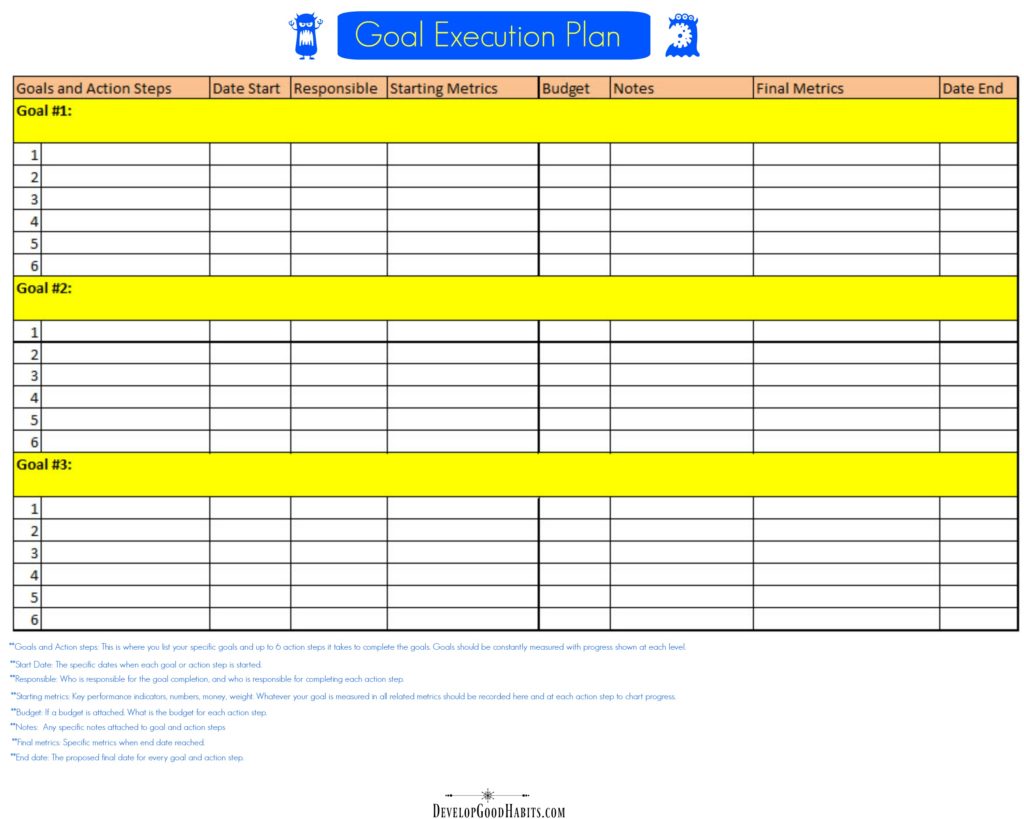
This worksheet includesaction items that need to be tracked. This is the goal you want to use of part or all of these goal worksheet action items that need to be completed by other people.
If you have big, hairy goals, with multiple moving parts, this simple one-page document is the things for you.
This goal setting worksheet has space for 3 goals, which is the most goals you really want to be actively working on at any given time. It also has room under each goal to track up to 6 different action items needed to complete each goal.
I would still recommend using the SMART goals setting worksheet to create your goals. There is only room on this chart to create your goals. So there is no way to measure if the goal itself has any inherent errors that may make it impossible to complete.
This is where you list your specific goals and up to 6 action steps it takes to complete the goals. Goals should be constantly measured with the progress shown at each level.
Key performance indicators, numbers, money, weight. Whatever your goal is measured in all related metrics should be recorded here and at each action step to chart progress.
A simple worksheet, this form is for a student, or child at home to encourage their goal setting efforts. These goals should be simple and include whatever the child thinks they need to work on. Not tasks assigned by adults.
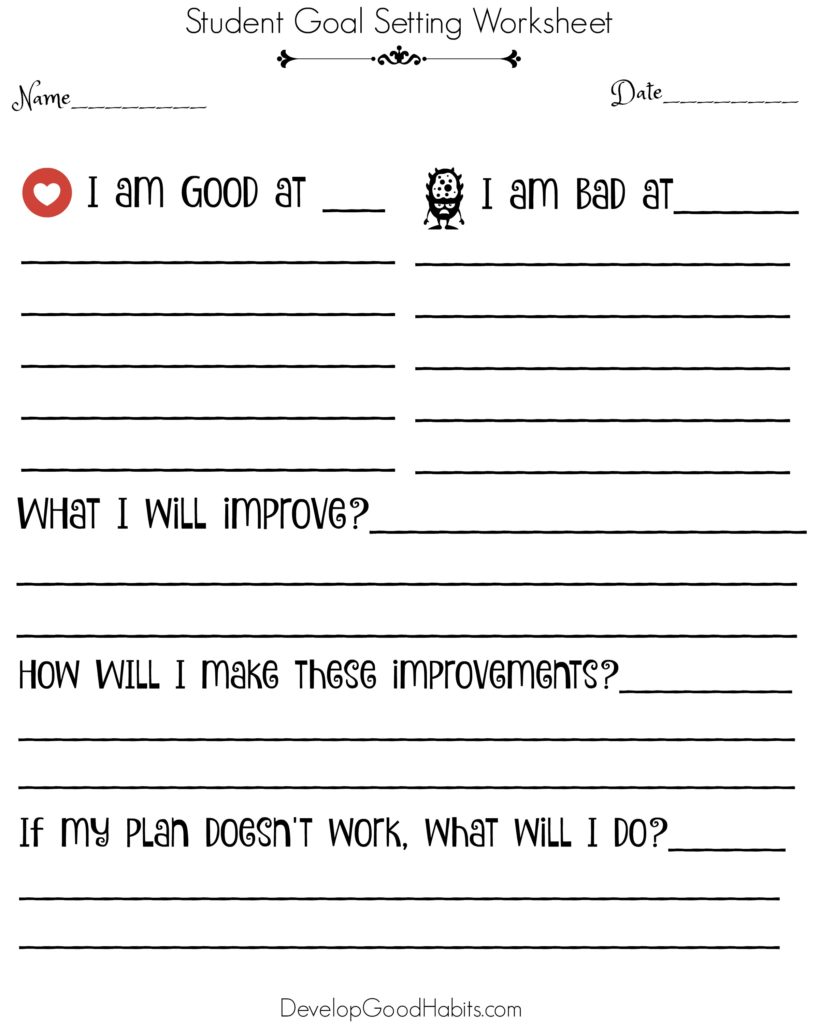
The Student or Child’s Goal Planning Worksheet is a simple form made for students at school, or a child at home to get them started planning and implementing their own goals.
The first two sections of the form have the child analyze their strengths and weaknesses to decide on an area they need to improve.
The next section has them commit to a specific improvement.
The fourth section of this goal worksheet has the child layout, in their own words a specific plan for improvement.
Finally, the child is taught “if-then” thinking by deciding what to do if the plan they have made is not successful.
The power of this goal setting form is in the title. It is simple and basic, yet it still covers some areas that could cause a goal to fail.
There are a few important parts to help accomplish your goals.
The first part is a specific start and completion date. When you do not tie goals to specific dates, you are doomed for your goals to fail.
The next helpful part is the steps to reaching your goal. This makes you think logically about what the goal entails and helps you break it down into smaller and easier parts.
Finally, the two things that help you reach your goal will make you think about things that may help you succeed. For instance, many personal goals are helped by accountability, where you tell others about your goal for encouragement and support.
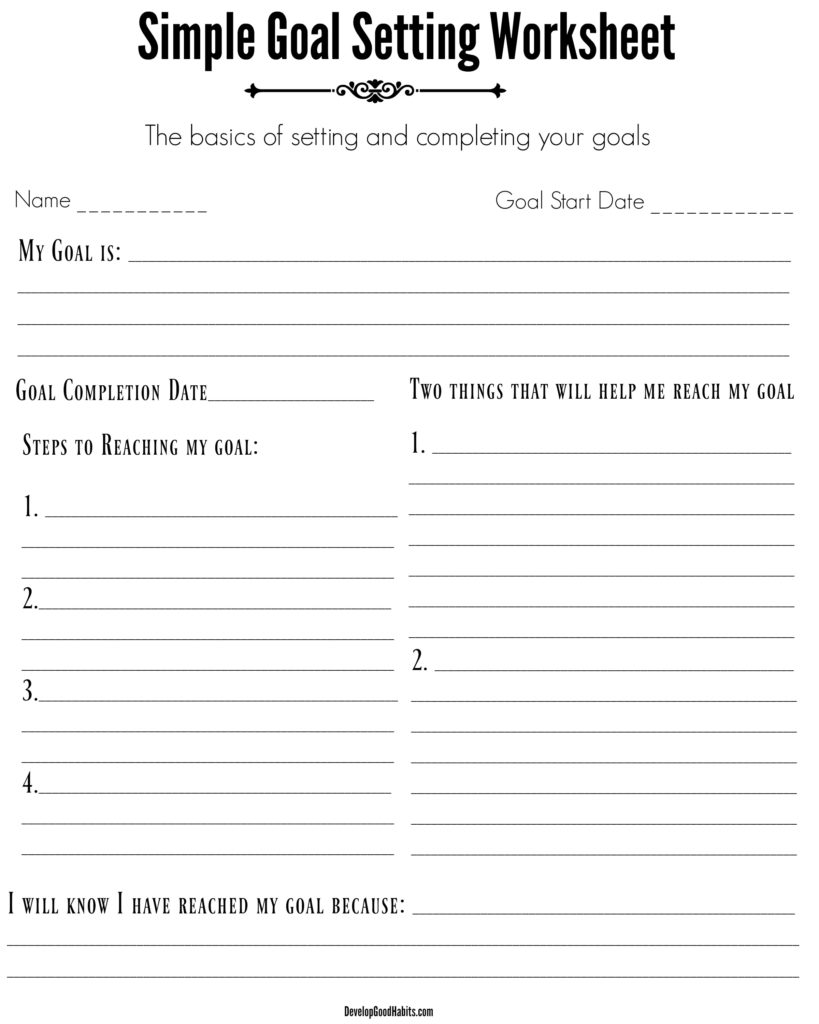
Setting short-term and long-term goals are important when it comes to improving your focus. One of the many benefits of setting goals is that it helps to propel you forward because it gives you written, step by step instructions on how to achieve your goals while also allowing you to set a date for accomplishment.
Goal planning provides you with the reminder you need to do continue doing what you have to do and allows you to stay in that growth mindset as you work on achieving your goals.
The SMART goals template we have provided above is a good place to start because you are setting realistic goals that are achievable. These worksheets also allow you to identify your priorities while setting milestones as you work toward your listed goals and objectives.
Setting a goal also helps us to believe in ourselves and what we can achieve. Goal setting isn't just about the plan we put in place; it is about finding the inspiration we need while aiming for what we didn't think was possible.
Are you a fan of the SMART Goal setting worksheet? Or do you prefer a bit simpler goals sheet? Maybe the SMART Goal sheet doesn't cover enough for your needs, and you want something a bit more robust and functional?
Whatever your feeling, please let me know in the comments below.
Mainly: How do you like these goals? What could we do to improve these goals printable? If you want more goal printables, what would they be?
The only way we can improve the content of this page, and give you more free downloadable stuff is to have a better idea of what you want.
Also if you'd like to discover additional information on this topic, then I suggest you check out the following articles: